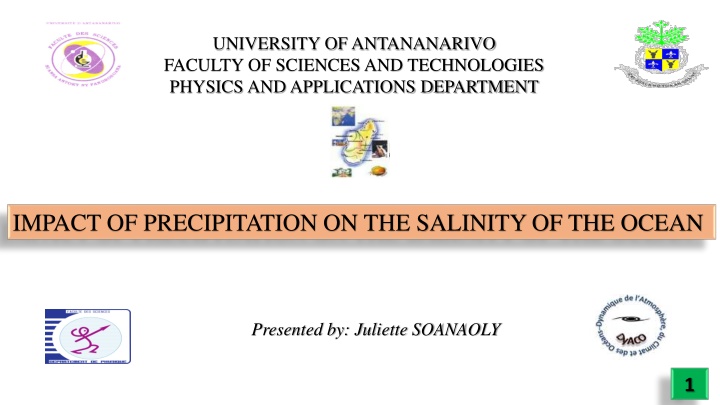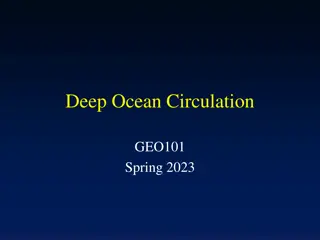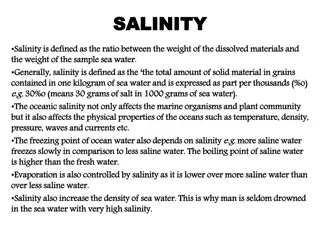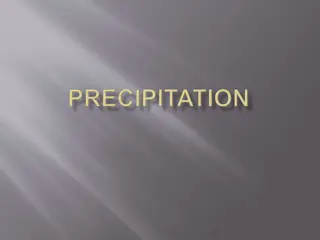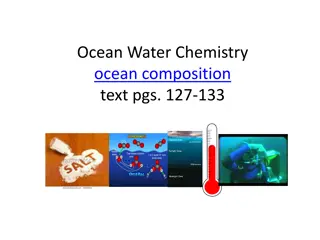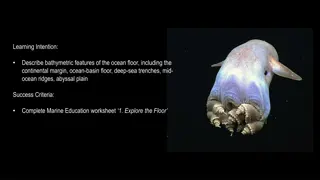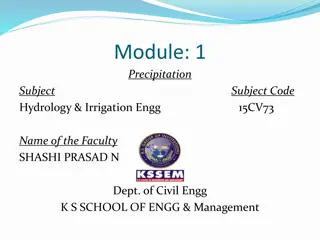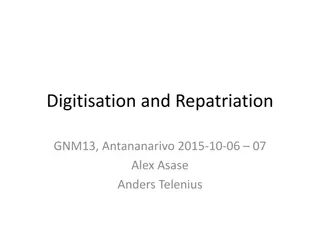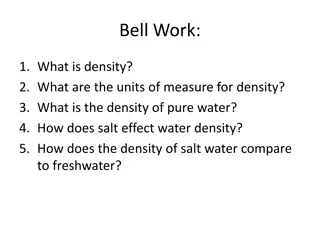Impact of Precipitation on Ocean Salinity: Study at University of Antananarivo
Juliette Soanaoly from the University of Antananarivo presents a study on the impact of precipitation on ocean salinity. The research explores the intercorrelation between rainfall and salinity, variability of precipitation in a specific study area, and the methodologies used to analyze the data over a 38-year period (1980 to 2017). Results indicate fluctuations in precipitation levels and their effect on salinity trends, providing insights into the water cycle dynamics and climate change implications.
Download Presentation

Please find below an Image/Link to download the presentation.
The content on the website is provided AS IS for your information and personal use only. It may not be sold, licensed, or shared on other websites without obtaining consent from the author.If you encounter any issues during the download, it is possible that the publisher has removed the file from their server.
You are allowed to download the files provided on this website for personal or commercial use, subject to the condition that they are used lawfully. All files are the property of their respective owners.
The content on the website is provided AS IS for your information and personal use only. It may not be sold, licensed, or shared on other websites without obtaining consent from the author.
E N D
Presentation Transcript
UNIVERSITY OF ANTANANARIVO FACULTY OF SCIENCES AND TECHNOLOGIES PHYSICS AND APPLICATIONS DEPARTMENT IMPACT OF PRECIPITATION ON THE SALINITY OF THE OCEAN Presented by: Juliette SOANAOLY 1
PLAN INTRODUCTION METHODOLOGIES & RESULTS CONCLUSION & PERSPECTIVE 2
INTRODUCTION Current climate change is compounded by the water cycle. Climate models remain very imprecise about changes in freshwater flows over the oceans, while most precipitation (78%) and evaporation (86%) occur. Sea surface salinity (SSS) could be a time- integrated tracer of changes in the freshwater balance on the ocean, subject to ocean circulation knowledge. 3
OBJECTIVES Intercorrelation between salinity and rainfall Variation of salinity after a rainy event 4
STUDY AREA Between: 22 and 28 South latitude 50.5 and 54 East longitude 5
METHODOLOGIES DATA: Precipitation from the ECMWF site and salinity from the NOAA site covering the 38 years (1980 to 2017). CLIMATOLOGICAL AVERAGE: to characterize or measure the daily, monthly and annual data. 1 T T = x X (1) t = 1 t 6
METHODOLOGIES to know the phase difference between the two data used and their degree of similarity. INTERCORRELATION: cov( ( , ) Y X Y = ( , ) t t cor X Y t t (2) ) ( ) X t t 1 N N = cov( , ) [( )( )] X Y X X Y Y t t t t t t i i = 1 i 7
RESULTS INTERCORRELATION BETWEEN RAINFALL AND SALINITY Annual intercorrelation between salinity and rainfall Monthly intercorrelation between salinity and rainfall 8
RESULTS VARIABILITY OF PRECIPITATION This region receives rainfall almost every months, but its minimum value is in September. 9
RESULTS VARIABILITY OF PRECIPITATION There is a downward trend, that means, the precipitation decreases during the study period (1980 to 2017). 10
RESULTS SALINITY VARIATION AS A FUNCTION OF DEPTH In general, the value of salinity between the first 15 meters is around 33.97 psu to 34.27 psu and it becomes more and more salty from the 6th meters. 11
RESULTS SALINITY VARIATION AS A FUNCTION OF DEPTH 12
RESULTS SALINITY VARIATION AFTER A RAINY EVENT ( 1m to 5m deep) The salinity on the first 5 meters becomes desalted during the rainy season but it is important during the dry season. 13
RESULTS SALINITY VARIATION AFTER A RAINY EVENT (6m to 15m deep) From 6th to 15th meters, it becomes desalted about 5 months after rainfall. 14
CONCLUSION The two climatic parameters (precipitation and salinity) that we studied are closely related. Salinity is a good indicator of the hydrological cycle variability. Salinity variation after a rainy event is a function of the ocean depth, it depends on the depth level that one would like to measure. During the rainy season, salinity at the first five meters desalt as the rain falls. On the other hand, from 6th to 15th meters, it is still waiting a few months. 15
PERSPECTIVE To study the other climatic parameters related to the water cycle: -Sea Surface Temperature (SST) -Evaporation 16
